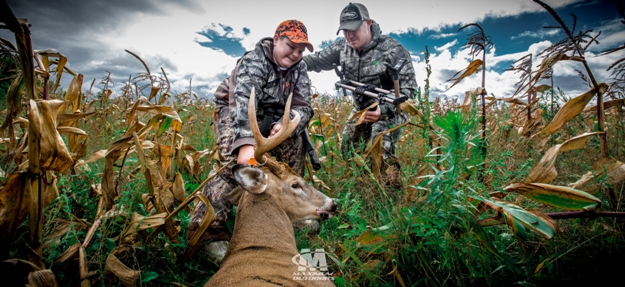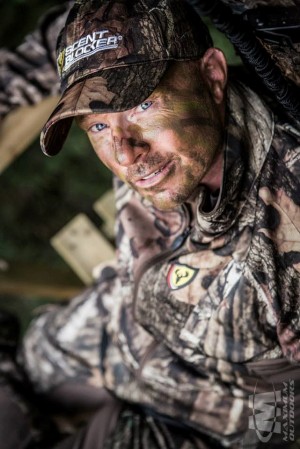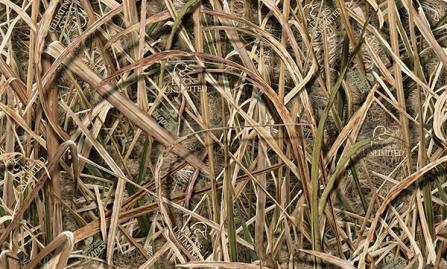
Editor’s Note: Mossy Oak Pro Steve Noble lives in Deckerville, Michigan, an hour east of Saginaw. He’s been hunting whitetails for 26 years and been a member of the Mossy Oak Pro Staff for 4 years. He’s also one of the hosts of “Maximum Outdoor TV” on the Sportsman’s Channel and the Pursuit Channel. The show is primarily about hunting whitetails, but also includes mule deer, moose, elk, antelope and bears and turkeys in the spring, as well as some back-country fly-fishing trips. Both Steve and his co-host Chris Garza have hunted in Illinois the last 10 years. Their Michigan hunts are primarily family hunts for Noble’s children, 12-year old Caleb and 10-year old Bella, and Garza’s children, his daughters 10-year old Madison and 6-year old Mya and son 8-year old Hunter.
Illinois has the soil types and the agriculture and the deer genetics to produce big deer year-after-year. The management system we use to attract and hold mature bucks is working. We use Covert trail cameras to identify and keep up with the movement patterns of the bucks on our property. The main farm is 134 acres, and drainages run into some timber on the property, forming an island surrounded by agriculture, about 1/2-mile from the Spoon River. Also, we have a 40-acre plot across the road from our 134-acre main farm and a 37-acre property on the edge of the Spoon River that butts up to the property where the Bryant Buck that scored 303 inches on Boone and Crockett was taken – the third, largest nontypical buck of all times. Between all three pieces of land, we have 24 trail cameras we monitor regularly. On our 134-acre main farm, we make sure that we have an abundance of food available for the deer all year long. We plant Mossy Oak BioLogic Clover Plus and rotate our crop fields with corn and soybeans. We harvest these crops, but we leave quite a bit unharvested for the deer.
 About 3-years ago, we made a decision that we believe has tremendously impacted our ability to attract and hold older-age-class bucks. We’ve made 60 acres of timber in the middle of our property a deer sanctuary that we never enter. From our game cameras, we’ve discovered that the impact of our going into and out of those 60 acres spooks more deer than we take. We’ve learned that the deer are actively moving during the daylight hours, unless we go there during daylight hours. In years past, within 60 days of hunting the interior of our property, the deer became completely nocturnal and only moved during the nighttime. Once we realized what was happening, we removed all our tree stands from that 60 acres. Today, we don’t go any closer than to within 100 yards of that sanctuary.
About 3-years ago, we made a decision that we believe has tremendously impacted our ability to attract and hold older-age-class bucks. We’ve made 60 acres of timber in the middle of our property a deer sanctuary that we never enter. From our game cameras, we’ve discovered that the impact of our going into and out of those 60 acres spooks more deer than we take. We’ve learned that the deer are actively moving during the daylight hours, unless we go there during daylight hours. In years past, within 60 days of hunting the interior of our property, the deer became completely nocturnal and only moved during the nighttime. Once we realized what was happening, we removed all our tree stands from that 60 acres. Today, we don’t go any closer than to within 100 yards of that sanctuary.
In the middle of the sanctuary is a big ravine with numbers of finger ravines coming off of it. The main part of the big ravine is where our deer are bedding and holding. We’ve cleared about 2 acres inside the sanctuary and planted Mossy Oak BioLogic Maximum there. We’ve also planted several food plots on the edge of the 60-acre sanctuary, so the deer can step out of the sanctuary and feed in those food plots. If they hear or see danger, they can get back in the sanctuary with one quick hop.
Once we set up that sanctuary and didn’t violate it, we noticed the big bucks moved around in the sanctuary and came out of it during daylight hours. From our trail-camera studies, we learned that the bucks were better at patterning us – they knew when and where we moved - than we were at patterning them. To take some of these mature bucks, we set-up stands on food plots just outside the sanctuary and stands on scrapes. In our area, we hunted our scrape line stands around Halloween, because we knew the big bucks were working those scrapes to find receptive does. Even though the deer might hear the sound of our rifles when shot, they never encountered any human odor coming in to the 60 acres.
As game managers, Chris and I believe success is when we hold mature bucks on our lands all year long. If those older-age-class bucks aren’t on your property, you don’t have a chance to take them once deer season arrives. We've come to realize, as important as food plots are, sanctuaries may be as important if not more important than food plots in holding mature bucks. I don’t think there is any greater reward that we can get each year than seeing pictures of the bucks that we expect to see on our property year-after-year. This year, seeing those pictures was really important, because epizootic hemorrhagic disease (EHD) hit our farm several years ago. Some of our older-age-class bucks were taken out of our herd by the EHD. When we added the number of deer killed by EHD with the three out of the four hit list bucks we had planned to take that year, we were almost too successful. So, we started passing on 3-4-year-old bucks, in hopes of taking these bucks once they reached 5-1/2- to 6 years. Luckily, that happened. Our trail-camera survey indicates that we have between 25 and 30 bucks from 1-1/2- to 7-1/2-years old on our land right now.
To learn more about deer hunting, check out John E. Phillips’ new eBook and print book, “Bowhunting Deer: Mossy Oak Pros Know Bucks and Bows.” You also can download a free Kindle app that enables you to read the book on your iPad, computer or Smartphone.
For information on making jerky from your deer to provide a protein-rich snack, you can download a free book from http://johninthewild.com/free-books.
Day 1: Finding the Promised Land of Deer Hunting
Tomorrow: Having More Bucks Than Does on Your Land






























